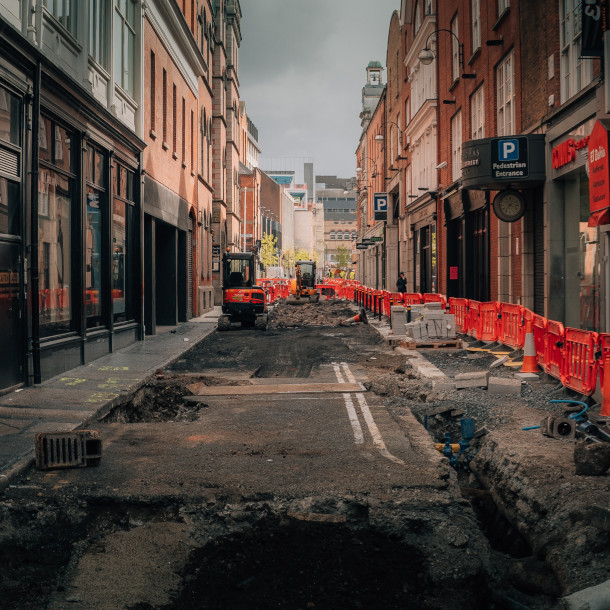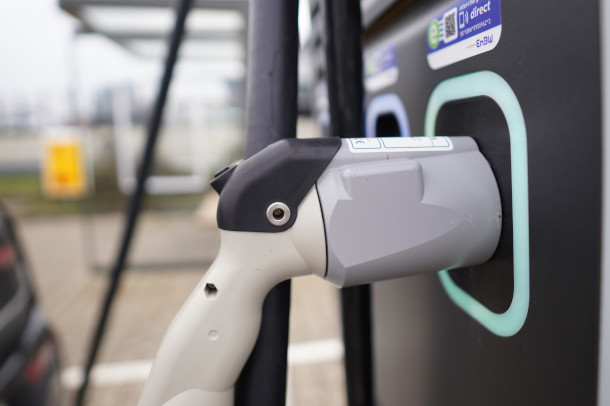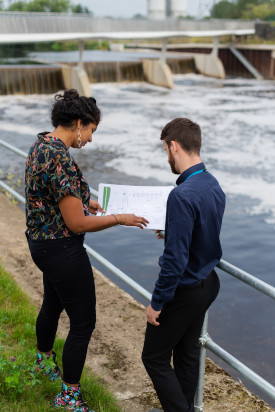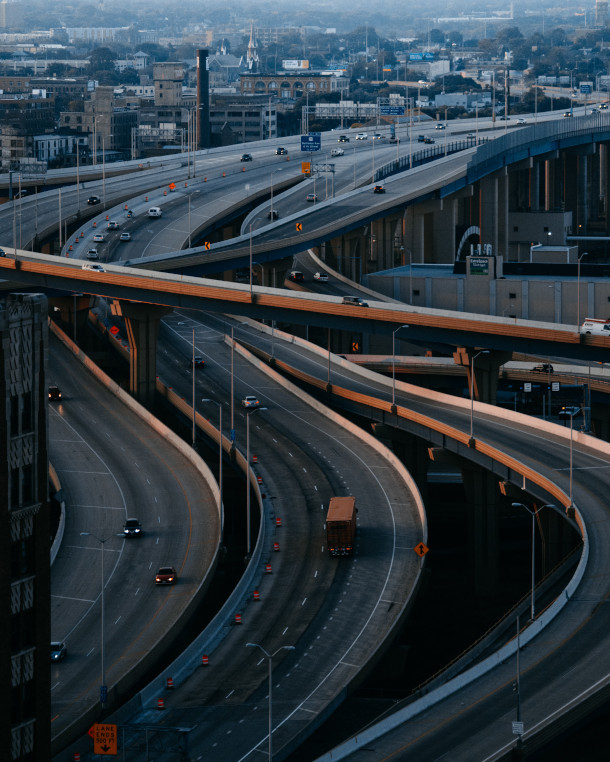A Generational Investment
Air Date: Week of November 19, 2021

“Shovel ready” projects like paving roads and fixing potholes are some of the first that will be addressed by local governments with the infrastructure funds since many already have implementation plans in place.But new rules could require localities to also consider equity concerns.(Photo: Majestic Lukas on Unsplash)
The bipartisan infrastructure bill sets aside $1.2 trillion dollars in funding for clean water, bridges, and roads, as well as higher-tech infrastructure like EV charging stations and electric school buses. Joseph Kane, a labor economist at the Brookings Institution, joins Host Steve Curwood to talk about how the implementation of these projects needs to focus on creating equitable and sustainable systems that will last for generations.
Transcript
BASCOMB: From PRX and the Jennifer and Ted Stanley studios at the University of Massachusetts Boston. This is Living on Earth, I’m Bobby Bascomb.
CURWOOD: And I’m Steve Curwood.
When President Biden recently signed into Law the “Infrastructure Investment and Jobs Act” it set into motion activities that could last for years or even decades. Now instead of Congress signing off on a piecemeal basis to repair broken bridges, clean up water supplies and build with climate smart tech and resilience, there is a federal pot of $1.2 trillion set aside for the next five years to address infrastructure on a strategic and sustainable basis. And at the start, a challenge for the feds, states and localities is figuring out how to share these vast resources equitably. Joe Kane is a labor economist who thinks about infrastructure as a Fellow at The Brookings Institution in Washington, DC, and he’s on the line now. Hi Joe, welcome to Living on Earth.
KANE: Thanks for having me.
CURWOOD: So tell me, how well prepared are states and local leaders to move forward with infrastructure plans, now that, what, half a trillion dollars in new money plus reauthorization of old money is moving ahead out of the federal government?

Many water utilities around the nation are still serviced by lead pipes potentially contaminating drinking water. With more funding from the infrastructure bill these pipes can be replaced. (Photo: Jacek Dylag on Unsplash)
KANE: Yeah, we're now past the, what I like to call, the political phase of the infrastructure bill on Capitol Hill, and now we're quickly transitioning to an implementation phase at a federal state and local level in terms of actually getting all this new funding out there, to different projects and and to different communities. States and localities are our primary infrastructure owners and operators, when you think of transportation departments, water utilities, planning departments, they all have tremendous oversight of these issues. And at the end of the day, they're going to ultimately determine the full reach and impact of a lot of this funding. But, you know, not all places are going to be evenly ready to hit the ground running in terms of having all the plans on the books, having all the data, having even the staff in place to implement all this. So I think it'll be interesting to see you in the next few months and years to come.
CURWOOD: So you're a labor economist. And there are a couple of layers of workers involved here. First of all the knowledge workers who know about what could happen, and we're talking about innovation here, I think we kind of figured out how to make roads, you know, paving them and such, but say designing an electric vehicle charging station system for a locality, or something that's relatively innovative, people are going to have to know about them and know how to apply for them. And then on the other side, you have the workforce that's actually going to build this stuff out. So where do we stand on both of those counts what do state and local governments have in terms of people who will be all set to work up applications for these innovations? And how are we set for people who will actually be able to implement them?

EV charging stations are one of the newer technologies that received $7.5 billion in the infrastructure bill. (Photo: Sophie Jonas on Unsplash)
KANE: Now, that's a great point. And for a very long time in the infrastructure space, workers have been overlooked in a lot of these conversations, I think. Especially among political leaders who often control the purse strings here and not not just in Washington, but at a state and local level, mayors, governors and others. It's a lot easier to focus on the ribbon cutting at the bridge, or the shiny new object and not so much, who is exactly going to be responsible for constructing this facility. And more importantly, who is going to be responsible for operating and maintaining it for decades to come? Because that's the point of infrastructure, I think, ideally, is it supposed to be long lived, the reality is, unfortunately, the talent pipeline to fill many of these positions is empty. It's not just about job growth, you know, and having new solar installers and wind turbine technicians who, who definitely matter in terms of new types of jobs emerging here, but it's about replacing some of the skilled talent that's already in this space. And many of these workers are aging, similar to the infrastructure they're taking care of. They're at the end of their careers. And, and so we have to fill this pipeline, and that does start often at a state and local level. And some of those same agencies that are taking on these projects, where are they going to hire and train the future infrastructure workforce, and often they haven't done that. And so this as much as this can serve as an opportunity, and a springboard to connect to more and different types of workers in this space is a crucial opportunity not to be overlooked.
CURWOOD: Well, so where are the resources for state and local government to get people trained? What's there to support education? I'm thinking of everything from community college, vocational, places where maybe it's many years in school, maybe it's a few months of education. What resources does this funding offer so that a state or a locality could start to get these people trained? Or they have to reach in their own pockets for this?

The workforce is often overlooked in the planning of infrastructure. Administrators, planners, and grant writers should be considered as much as construction workers. (Photo: This is Engineering on Unspalsh)
KANE: Yeah, again, another another good question that we don't quite know the answer to yet. I will say initial proposals put forward by the Biden administration had much more dedicated funding, for apprenticeships, for Earn and Learn opportunities for many of these positions that are in the skilled trades that emphasize on the job training, not necessarily advanced levels of formal education. And that was stripped out from this bill. A lot of it now appears in the second reconciliation package, that's still up for debate. And so that still is to be determined to the extent that that funding comes through. But at the end of the day, states and localities often have to coordinate with employers directly. So not even just public agencies, but private employers, construction firms, consulting companies, design firms, they all have to have skin in this game to because they have to provide the opportunities for workers to actually get the immersion and exposure to the types of work in this space. It's not a simple matter of just hiring someone on the job and it's over, you know, we have to have continued training, you have to have certifications, you have to demonstrate competencies over time. And ideally, we're not just training, you know, entry level workers to kind of fall off a cliff but, but ultimately can become the managers and leaders of tomorrow.
CURWOOD: Let's talk about equity. I mean, what can states and localities do to ensure equity when making these plans and ensure that underrepresented community needs are met? It's a no brainer that the infrastructure is often the worst in poor and minority communities. I mean, lead pipes are famous there, the bridges, the roads are tough. Hello, is there an internet in this part of town? How can the equity question be addressed with all this money coming at these things?

Joseph Kane of Brookings Institution. (Photo: Courtesy of Joseph Kane)
KANE: Absolutely, I mean, economic equity should be foundational to how we plan design, operate our infrastructure, not just simply construct it, but actually operate it over time. And for a very long time, you know, going back, I'd say that broken 20th century framework, which we tend to rely on across the country, you know, we often don't design around people and place. We often design around cars, we design around physical things. And that creates a destructive legacy in many places where we literally have created highways that have carved through whole communities and disconnected them from opportunity. And so a fundamental rethinking, I think of some of these legacy costs, and hopefully benefits that could come out of, of this rethinking involves certainly new types of plans and community engagement, actually involving those who have been marginalized and excluded in these conversations matters. Having new types of data and performance measures. If we are not actually integrating new types of data into how we're measuring where we should target these investments, if we're just simply relying on Hey, that roads congested, let's just throw more money at it and widen it. I mean, we're kind of missing the point, right? Because we need to actually identify who's using that road. Is it serving all types of users? Is it dividing a community? And that's just for transportation? I mean, for water infrastructure? What is, you brought up the lead pipe issue, certainly in communities like Flint, but many others across the country. Where are those pipes even located? I mean, we have more than 50,000 water utilities across the country. And it's very difficult to pinpoint exactly where some of those legacy issues even are. And so as much as we just throw money at the problem, that's not necessarily going to solve all of this as much as if we have better plans and better data and better performance measures to target those investments. Because, you know, half a trillion dollars is a lot of money, but it's not infinite, right? And if we really want to stretch the dollar, to help more people in places, we have to better measure where those monies are going.
CURWOOD: Joe, what you're describing, that needs to happen is going to take longer than any particular presidential term, maybe even longer than a couple of presidential terms. And right now, our political environment is well, I guess maybe one could use the word volatile. How does this get implemented on a sustainable basis? Above the rather bitter, almost sometimes no prisoners taken political process we have?

Highways have historically been built through minority neighborhoods, decimating communities. Equity needs to be at the forefront of new infrastructure plans. (Photo: Tom Barrett on Unsplash)
KANE: Yeah, look, I mean, we're fortunate in that infrastructure is traditionally a bipartisan issue. You know, elections can be disruptive in the sense of where's the funding certainty for some of these projects? And I think that's been the challenge for a lot of state and local governments who have had to weather this storm. But I think the hope has to be that in the creation of these new programs, and the creation, and execution and implementation of these programs, are they creating sustainable benchmarks, right, by which federal agencies can keep this going over time, regardless of who's sitting in the White House? I think that has got to be the hope here is that when we do all this legwork on implementation, which is why I emphasize this phase we're in right now is so crucial, that everyone kind of was focused on Capitol Hill, and kind of the politics and the horse trading of all this, which which mattered in terms of the final dollar sign. But we have to move past dollar signs and alarm bells. And we have to understand that this challenge is very nuanced, it's generational, it's going to require a lot of rolling up of sleeves at the federal level in coordination with state local governments to create those programs. So it's an understanding of, hey, this is how we do things, right. Climate is centered and how we design and measure the needs of projects. We're going to center this around workforce development and making sure we have a sustained pipeline of talent, that we can actually fill the roles that we need to fill. These are the sorts of questions leaders need to keep asking themselves as a result of this moment. And it shouldn't just be over the next five years. It should be a conversation we're having ongoing right regardless of who's in office.
CURWOOD: Joe Kane is an economist and Fellow with the Metropolitan Program at The Brookings Institution. Joe, thanks for taking the time with us today.
KANE: Thanks again for having me.
Links
Read more about Joseph Kane’s work
Watch the video of President Biden signing the infrastructure bill into law
Read more about the infrastructure bill on the White House website
Living on Earth wants to hear from you!
Living on Earth
62 Calef Highway, Suite 212
Lee, NH 03861
Telephone: 617-287-4121
E-mail: comments@loe.org
Newsletter [Click here]
Donate to Living on Earth!
Living on Earth is an independent media program and relies entirely on contributions from listeners and institutions supporting public service. Please donate now to preserve an independent environmental voice.
NewsletterLiving on Earth offers a weekly delivery of the show's rundown to your mailbox. Sign up for our newsletter today!
 Sailors For The Sea: Be the change you want to sea.
Sailors For The Sea: Be the change you want to sea.
 The Grantham Foundation for the Protection of the Environment: Committed to protecting and improving the health of the global environment.
The Grantham Foundation for the Protection of the Environment: Committed to protecting and improving the health of the global environment.
 Contribute to Living on Earth and receive, as our gift to you, an archival print of one of Mark Seth Lender's extraordinary wildlife photographs. Follow the link to see Mark's current collection of photographs.
Contribute to Living on Earth and receive, as our gift to you, an archival print of one of Mark Seth Lender's extraordinary wildlife photographs. Follow the link to see Mark's current collection of photographs.
 Buy a signed copy of Mark Seth Lender's book Smeagull the Seagull & support Living on Earth
Buy a signed copy of Mark Seth Lender's book Smeagull the Seagull & support Living on Earth

